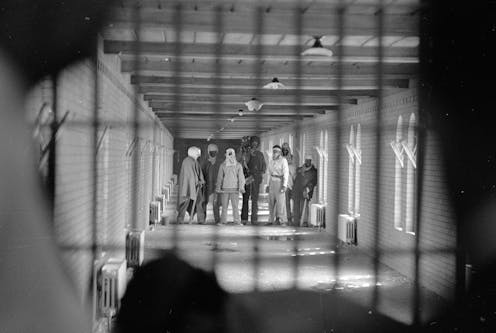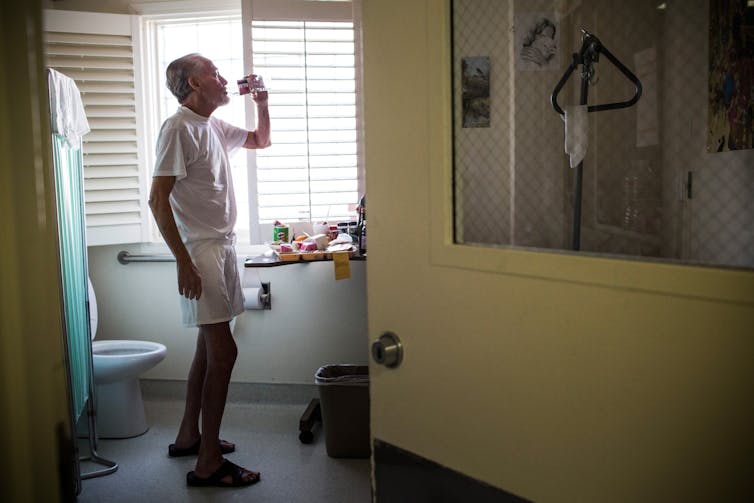On 50th anniversary of Attica uprising, 4 essential reads on prisoners' rights today
The Attica uprising marked a milestone in the prisoners’ rights movement. Many of the grievances aired in 1971 are still relevant to today’s incarcerated population.

On Sept. 9, 1971, nearly 1,300 incarcerated men at Attica Correctional Facility in New York state took control of the facility, prompting a multiday standoff with authorities that ended in a massacre.
The incident resulted in the deaths of 43 people, many of them inmates, and marked an important moment in the prisoners’ rights movement in the United States. The men behind what has variously been described as a “riot,” “rebellion” and “uprising” at Attica were demanding improvements to medical and food supplies behind bars, greater visitation rights and an end to insanitary conditions and guard brutality.
The uprising took place before the huge increase in America’s prison population in the 1980s and 1990s. But as The Conversation’s authors have explained in recent months, many of the grievances raised by the Attica prisoners – health care, visitation rights, brutality and neglect – remain a concern for today’s incarcerated men and women. Here are four essential reads:
Behind bars and suffering from dementia
America’s prisons are facing a growing aging population. Research shows that by 2030, almost one-third of all incarcerated people will be over the age of 55. Rachel Lopez, a law professor at Drexel University and former commissioner on Pennsylvania’s Sentencing Commission, explains how the aging population will place an additional burden on authorities: Research has shown that by the end of this decade, up to 210,000 elderly prisoners will have dementia. The cost of their medical upkeep will fall on taxpayers.

Moreover, keeping someone with dementia behind bars is, Lopez argues, an affront to human dignity and may even violate the United States Constitution’s prohibition on cruel and unusual punishment.
“Forcing those who cannot understand their punishment to live the remainder of their days behind bars appears to be exactly the type of excessive and cruel punishment that the Eighth Amendment was meant to protect against,” Lopez writes.
Prisoners with intellectual disabilities
The elderly are not the only vulnerable population being kept behind bars. In March 2021, the Bureau of Justice Statistics revealed that around a quarter of the 24,848 incarcerated people it surveyed across 364 prisons had an intellectual, developmental or cognitive disability. Across the entire prison and jail network, that would equate to some 550,000 people. Jennifer Sarrett of Emory University conducted in-depth interviews with several adults within the criminal justice system who have intellectual and developmental disabilities.
“Prisoners with these disabilities are at greater risk of serving longer, harder sentences,” Sarrett notes.
They also run the risk of exploitation and abuse – both from other incarcerated people and from prison staff. As one man explained to Sarrett, officers look to see who only watches TV and never reads, marking them out for exploitation: “Some of the corrections officers … they’ll slide up onto the disability boy and use him, you know, making him feel like ‘This is my dog. This is my boy right here. Come and do this for me.’”
Meanwhile, needing extra time to process instructions – particularly in high-stress situations – can be interpreted as obstinacy by prison officers. In turn this can lead to prisoners with intellectual disabilities being written up for disciplinary issues, which can result in time added to a person’s sentence, removal of certain privileges or solitary confinement. A 2018 study found that over 4,000 people with serious mental health concerns were being held in solitary confinement in the U.S.
Guard brutality still an issue
Between 2012 and 2016, 128 state and federal prisoners died as a result of homicide or accident, according to the Bureau of Justice Statistics. Those were the most recent figures available to Heather Schoenfeld of Boston University when she wrote an article for The Conversation in July 2020 looking at violence by corrections officers. Another problem with the data other than it not being up to date: The agency does not distinguish in the figures between incidents involving prison staff and prisoner-on-prisoner violence.
“In the absence of detailed and reliable data, what we do have are accounts of sadistic and retaliatory violence by prison guards against people in prison,” Schoenfeld writes.
She describes an “ongoing humanitarian crisis” in U.S. prisons of excessive force by corrections officers that has only been made worse by understaffing and overcrowding. “Studies show that officers who work in chaotic and hostile work environments are more likely to adopt an ‘us vs. them’ mentality and resort to retaliatory violence,” she writes.
She adds: “Similar to excessive police force, brutality by prison officers is part of systemic state violence against people of color, and Black people specifically.”
Read more: People are dying in US prisons, and not just from COVID-19
COVID-19 and visitation rights
Brutality and neglect are not the only things killing America’s incarcerated population. Prisoners have been particularly vulnerable during the coronavirus pandemic. Incarcerated men and women living in cramped indoor conditions with only basic sanitation and poor ventilation are at higher risk of infection and death from the virus.
They have also face being isolated from their families for extended periods as a result of lockdown measures. Alexander Testa and Chantal Fahmy at The University of Texas at San Antonio looked at the effect this has had on the prisoners’ families.
The two scholars surveyed 500 people with a loved one serving time behind bars in Texas during the summer of 2020. What they found was a high level of concern.
“My son has been locked in a cell with temperatures over 100 degrees for up to 23-plus hours a day for weeks on end now due to COVID,” one 74-year-old woman told Testa and Fahmy. “I fear he will either perish from the conditions or somehow take his own life.”
The concern was not only of the risk of infection but also the sudden removal of visitation rights.
During the pandemic Texas prisons severely limited all types of contact with the outside world – including video and phone calls. Visitation was barred completely on March 13, 2020, and only resumed a year later.
Reflecting on the this, alongside other grievances including “deplorable” living conditions “and lack of medical and dental care,” one mother of an incarcerated person commented: “We don’t incarcerate, we torture.”
[Get the best of The Conversation, every weekend. Sign up for our weekly newsletter.]
Read These Next
What’s at stake in Trump’s executive order aiming to curb state-level AI regulation
In the absence of comprehensive federal AI regulation, states have stepped in. The Trump administration,…
The Bible says little about Jesus’ childhood – but that didn’t stop medieval Christians from enjoyin
Legends about Jesus’ early years that circulated in medieval Europe often drew on apocryphal texts.
Data centers need electricity fast, but utilities need years to build power plants – who should pay?
How many data centers will be built – and how much electricity they’ll need – is uncertain. Being…





